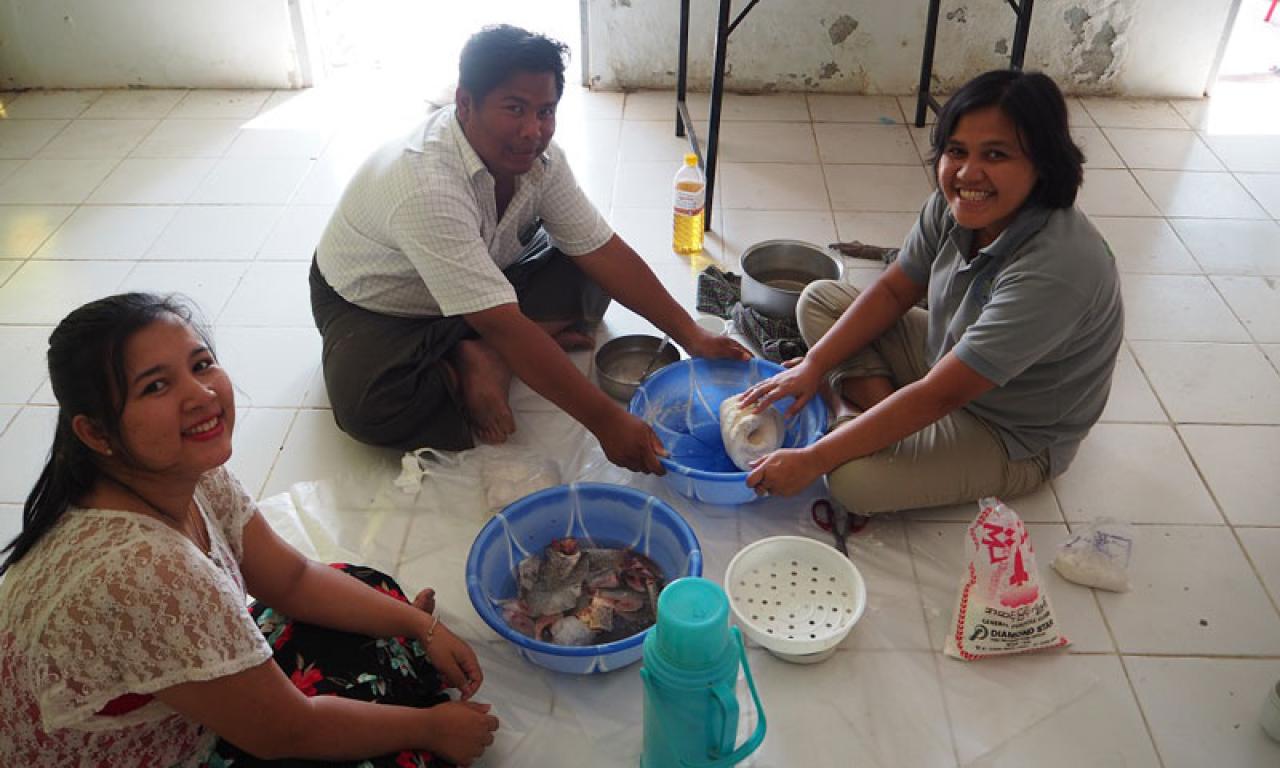
WorldFish is a global leader in aquatic food systems research and innovation for healthy people and planet. Science and partnerships are the foundation of our work. Our team delivers robust evidence to policy makers and technological innovations to producers, value chain actors and consumers in order to transform food systems. In this series, we feature our scientists in the spotlight, veteran researchers who have made a significant contribution to their field.
WorldFish is a global leader in aquatic food systems research and innovation for healthy people and planet. Science and partnerships are the foundation of our work. Our team delivers robust evidence to policy makers and technological innovations to producers, value chain actors and consumers in order to transform food systems. In this series, we feature our scientists in the spotlight, veteran researchers who have made a significant contribution to their field.
Quennie Vi Rizaldo is a Human Nutrition Specialist at WorldFish collaborating on the USAID-funded Fish For Livelihoods project to support small-scale aquaculture farmers and fishers in Myanmar. Her research supports improved nutritional outcomes in aquatic foods systems through use of nutrition-sensitive approaches, including the integration of diverse vegetable crops alongside farmed fish in homestead ponds. In her role, Rizaldo specializes in behavioral change and communication to facilitate the adoption of healthy eating behaviors, thus working to ensure both the production and consumption of nutrient-rich foods.
What are you currently working on for WorldFish?
I am currently collaborating with the private sector to develop dried small fish powder products. As the COVID-19 pandemic underscores the need for nutritious diets, my work to promote dried small fish powder is providing locally accessible and acceptable nutrient-rich foods that boost the health of young children in Myanmar.
Small fish are full of micronutrients that support cognitive development in children, especially during the first 1000 days of life. The main barrier to fish consumption in children is the potential for choking on bones. By grinding dried small fish into powder, we can safely incorporate their nutrients into children’s meals. Working with food processors in Myanmar, dried fish can be added to products regularly consumed by young children and pregnant women, such as soup mixes. I provide additional technical support to a food company to help them explore opportunities for products that suit the needs and tastes of the Myanmar market.
In addition, I am preparing a study to identify both the enablers and barriers to changing food consumption behaviors in women of reproductive age. The findings will inform us on how to tailor our approaches and better facilitate the adoption and maintaining of behaviors that support healthier diets.
What’s the most exciting thing about your research area?
I think collaborating with diverse stakeholders to adopt a systems approach to transforming aquatic food systems for more healthy and sustainable diets is an exciting development. This holistic approach, as opposed to individual efforts, will make food systems more effective. Unifying efforts from different sectors, ranging from production to consumption, will better support our ultimate goal of achieving adequate nutrition for all people, especially women and children.
How did you first become interested in researching nutrition-sensitive approaches in aquatic food systems?
Coming from the Philippines, I grew up eating a variety of fish daily. In retrospect, fish was the main provider of animal-sourced food in my community. However, there has been a modern shift in food consumption patterns to less healthy meats, processed foods, fats, sugar and oil – all harmful and unsustainable. I became committed to my work in order to support sustainable and healthy diets in low-income and rural households, in which fish and other aquatic foods play a key role.
How can small-scale aquaculture production in Myanmar incorporate more nutrition-sensitive approaches?
Small-scale aquaculture production can be nutrition-sensitive by adopting polyculture methods that incorporate a variety of small indigenous fish with larger species, such as carp. Aquatic food farmers can also grow fruits and vegetables in and around their homestead ponds in an integrated agriculture and aquaculture system. These methods lead to a wider diversity of foods available both at home and in the market. However, there is a need to facilitate the adoption of positive nutrition behaviors—consuming diverse and safe food—so that increased production will actually lead to consumption.
What innovation has the greatest potential to increase the consumption and accessibility of nutritious foods?
The development of processed fish-based products like fish chutney, fish wafers, and dried small fish powder will increase the accessibility of critical nutrients and reduce malnourishment in children. These products are manufactured locally and use raw ingredients that are cheap and widely available in country. Through engagement with the private sector, further advances in fish-based products and start-up investments can lead to employment opportunities for female entrepreneurs.
What do you wish you had known when first starting a career in science?
I wish I had been more familiar with the many examples of work from leading female researchers; they can be a source of motivation to continue the work despite the countless challenges faced while starting out in the field.
What piece of your scientific research are you the most proud of? Why?
I am proud of a recent study I conducted in the Ayeyarwady Delta, where I identified fish species and quantified the amounts of fish consumed by the rural women using a playdough model, which helps women recall the fish they have eaten. The model, comprised of flour, water, and oil, represented the size and number of fish consumed in the prior 24 hours. It was a novel approach, and completing the study was tough – it was a relief after I accomplished that piece of work. But through that research, I realized how vulnerable small-hold farmers and their families are because of their complete reliance on fish as a source of food and livelihoods.
What do you hope your research ultimately achieves?
I hope my research ultimately finds better ways to support low-income communities in achieving nutritious diets, whereby fish and aquatic foods are a crucial component. Through research like mine, policy makers can make evidence-based decisions to ensure that no one is left behind, especially in underserved rural communities.
